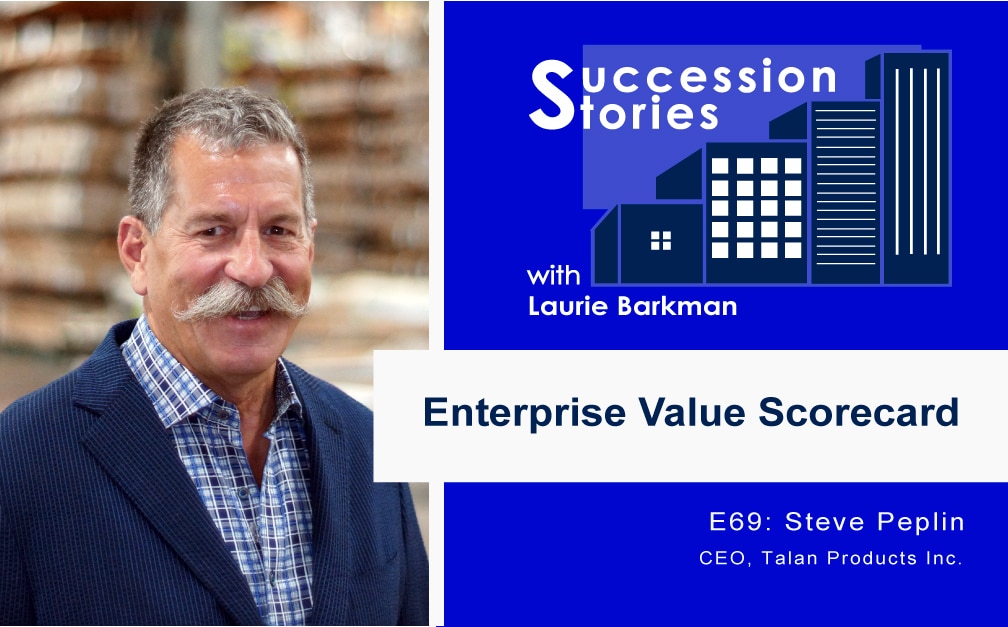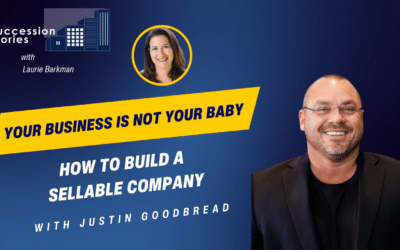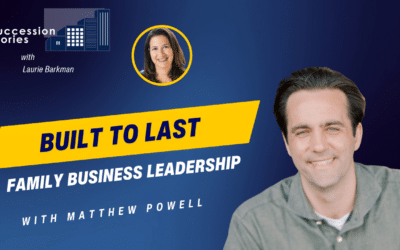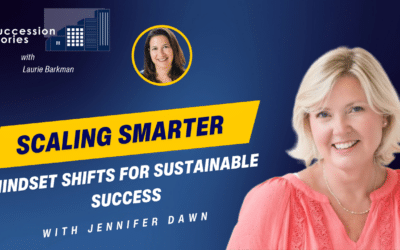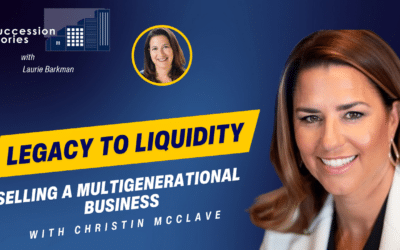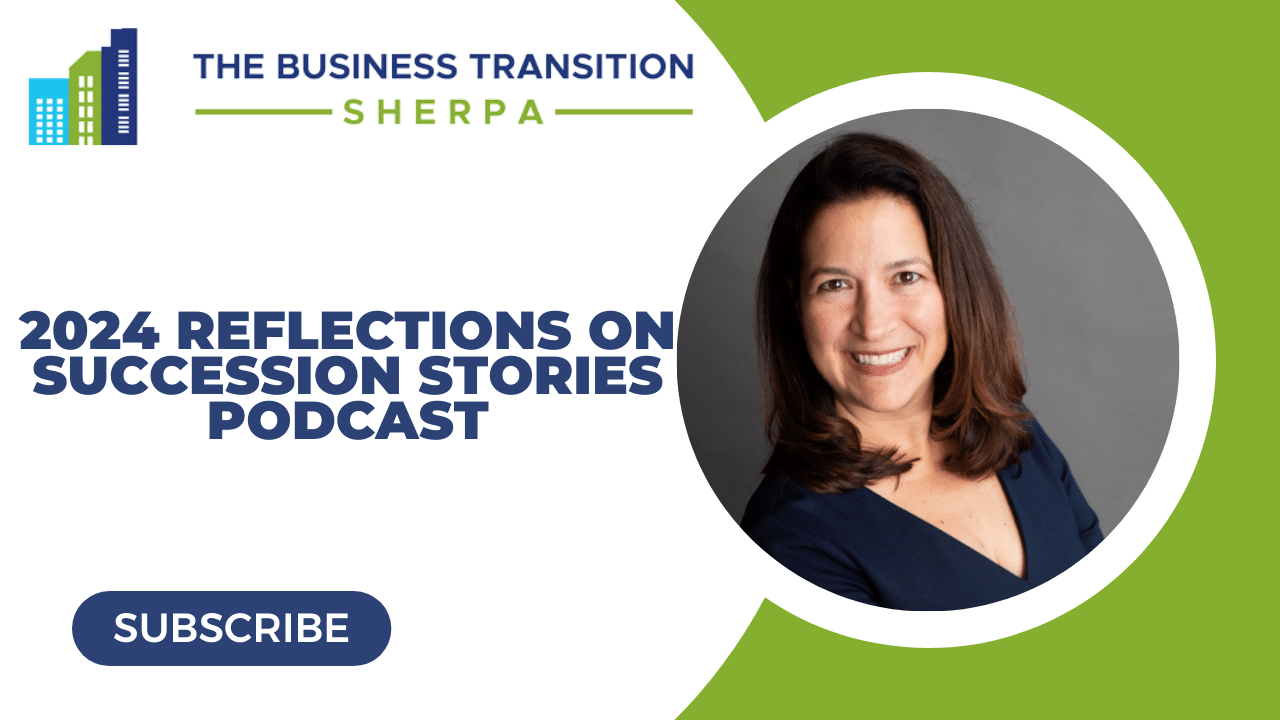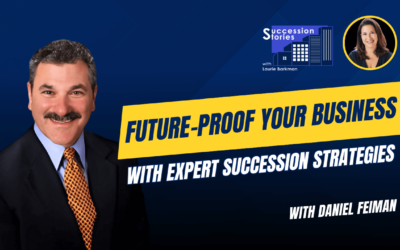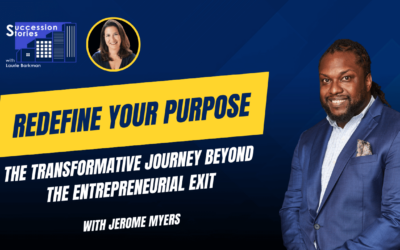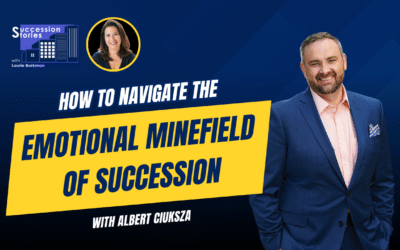All entrepreneurs will leave their company someday. What’s your path to increasing your company’s value? Steve Peplin, CEO of Talan Products, a $50 million manufacturing company, has achieved impressive growth. Listen in as Laurie Barkman and Steve discuss his secrets to success using enterprise value as a scorecard to improve the business. And how he thinks about the entrepreneurial journey, succession, and what comes next at a personal level.
Listen in to learn more about:
- The importance of talent acquisition, recruiting and retention in the current business landscape
- Building enterprise value from a buyer’s perspective
- Continuous learning as a key part of succession planning
- Preparing for your next
Show Links:
Steve Peplin LinkedIn: www.linkedin.com/in/steve-peplin-9095046/
Talan Products website: https://www.talanproducts.com/
Laurie Barkman on LinkedIn: https://www.linkedin.com/in/lauriebarkman/
Subscribe to Succession Stories to get all the weekly episodes!
Transcript:
Laurie Barkman:
As a lifelong entrepreneur, Steve Peplin has started and operated numerous companies, all in the specialty building trades or building products industries. Over the past 35 years, his manufacturing company, Talan Products, has grown to become a $50 million business with an impressive 18% growth rate. Steve credits their success to the company truly embracing their core values, and to differentiation — pursuing innovations in high growth market segments. I loved our conversation about what gets measured gets improved, and was really impressed by his understanding what drives enterprise value (a common theme on this show). We also discuss succession planning, perhaps you’ll relate to his contemplation of what’s next.
Laurie Barkman:
Steve Peplin, welcome to Succession Stories. I’m super excited to have you on today. I invited you onto the show because you are an entrepreneur and an adventurer. They kind of go hand in hand. Your bio is fascinating. Your bio includes logger, roughneck, cowboy, vertical construction worker, sailor. I know there’s other things there too, unicycler, hot air balloonist. I think you see life as an adventure, and I’m guessing you also see business that way. So I’m interested in speaking with you, welcome.
Steve Peplin:
Thank you, Laurie, this is exciting. We’ve been called by one of the local industrial organizations, their ‘poster child for business unusual’. I think they meant it as a left handed compliment that we were very progressive and innovative.
Laurie Barkman:
Tell us about your entrepreneurial journey. What’s your origin story, as they say?
Steve Peplin:
Oh, I’ve never had a job. Almost. I’ve been a rep, an independent rep, which is independent but I technically had a job when I was in high school, when I was young I had jobs but ever since I’ve grown up, I’ve never had a… I worked in college. I worked in a restaurant when I was going to college, but not much work; college got overwhelming after a while. So I’ve always been an entrepreneur. As a young person, I shoveled driveways, mowed lawns, painted houses…
I was at the end of my second year of college, I came back and I started a company for the summer between my sophomore and junior year of college. Well, the company did real well. I never went back and finished school, which is a common entrepreneurial trait and now I find a lot of my friends who run their own successful companies just never finished school. They got impatient. Now, for me, I did a mental assessment. I said, “Wait a second, I’m going to school to learn how to make money.” That was my goal, to make money, and I was making a lot of money. I like to say I didn’t start a company to get rich. I started a company to get filthy rich.
Laurie Barkman:
Now, your father was an entrepreneur. Correct? He had a manufacturing business?
Steve Peplin:
He wasn’t an entrepreneur, though. My father worked for his father. He was an employee. Entrepreneur, I think, means you’ve created something from nothing. You ‘started a startup’ is kind of the definition of an entrepreneur. Dad was a successful businessman and a super nice guy and very generous, great guy. I learned a lot from him. But yeah, no, he was not. My grandpa, on the other hand, was an entrepreneur.
Laurie Barkman:
Tell me about him.
Steve Peplin:
He had an eighth grade education. He started a company in the 40s and became very successful. He had patents, he was a really interesting guy. He had partnered with Pat Parker from Parker Hannifin. Cleveland was a super dynamic manufacturing spot. It is now still, but it really was, back 100 years ago. It was a world center for manufacturing.
Laurie Barkman:
So you have what I call the entrepreneurial gene —
Steve Peplin:
Yes.
Laurie Barkman:
That most likely came from your grandfather. That’s really good.
Steve Peplin:
I think it skips a generation.
Laurie Barkman:
Probably does. So tell us about Talan Products. What does the company do? You were one of the founders. Tell us the story about launching the company.
Steve Peplin:
Well, we’re a long run, high volume metal stampings – up to 600 times – progressive die specialists. We also fabricate a lot of aluminum extrusions. Mostly we stamp it. We build our own tooling. Our customer mix is like a high volume low mix, as opposed to a low mix high volume, which is typically called a fabricator. We predominantly make building products. We have some specialties in solar, a lot of our solar products go on buildings, LED lighting, a lot of the lighting goes into buildings, and electric vehicles, which is a new niche we’ve targeted recently.
We’ve had a history of attacking, or not attacking, but targeting disruptive industries. A lot of our building products 35 years ago, when we started, we went after the single ply roofing industry, which was a new way to put roofs on buildings, sort of a polymer sheet as opposed to asphalt paper like the old style. It was more labor intensive, the old way of roofing, single ply roofing. When we started, this company was 8% of the commercial roofing industry, and the industry back then was about $16 billion. Now it’s about $35 billion, and our niche single ply roofing is 80%. So we grew up with the industry, we targeted a disruptive industry and we rode the coattails. We did the same thing with LED lighting. LED lighting didn’t exist – it existed in the labs, but it was not commercialized 10 years ago, so we were some of the – I don’t want to say early adopters – we were early to the party and it went from a 0 to $100 billion industry in about seven or eight years.
Laurie Barkman:
Just for size, just to give us a sense, how many employees?
Steve Peplin:
80 employees, about $50 million. Those are good numbers for a metal stamper. Typically, metal stampers get sales of about $185,000-190,000 per employee. We’re north of $700,000. By that measure, we’re an extremely productive company. Because like I said, we do high speed, high volume our niche is ‘make a lot of parts’. We have certain part numbers, we’ll make hundreds and millions of pieces, they come off the press like if you’ve ever seen a beer bottling line where the beer is flying by so fast, you can’t even see it. That’s the way we manufacture.
Laurie Barkman:
I’ve done a little bit of research on your company, and you and I had talked prior to this episode. So I know that there’s some core values that the company has, there’s a lot of years of, of growth and I know it hasn’t been an easy journey, just like many entrepreneurial stories, but I do want to talk about a few of the core pillars that you mentioned on your website as part of your story and your history. It certainly starts with people, so I want to start there. One of the things that I saw is your company mantra to treat everyone right, and also, I think you’ve been on some other podcasts where you talk about your people. Recruiting is so important, especially now, in this market, where everyone is finding it challenging to find workers. So I thought if we could chat a bit about your culture, what it means at Talan Products, how you bring the fun, because you’ve talked about how you have a fun company. You don’t always hear that about a manufacturing company, but it’s a fun manufacturing company, and here it is, nestled in the middle of Ohio. So tell us about your culture.
Steve Peplin:
Well, we hire for our values and we also find that when we find customers to share our values, it’s usually a mutually successful, long lasting relationship. Our values, our core values, we’ve always had values going through the mission vision values thing 25 years ago, and it was a pillar of a well run company. But back then, values were not really lived. People made them, they went through the exercise, they put the values on the wall, they gave out wallet cards, but I don’t think people really bought into the whole concept. They were something that consultants said you had to do to be a worldwide company so people did it.
Recently, probably five or 10 years ago, we boiled it down to four core values. It’s a lot easier to remember four values than 13. Also when we looked at the 13 days, a lot of them were redundant, and they’re understood. You don’t have to put it in profitability as a value. If you’re not profitable, you don’t exist, the company will cease to exist, so that was understood. We started with safety because in a metal stamping plant, we have big presses, 30,000 pound coils of steel; accidents can be catastrophic. So you really have to put safety above everything. Above productivity and above profitability. It just has to. To be a good company, to be a good person, to sleep at night, you want to put safety number one. Then I look at the next three as the values that are – not negotiable – but these are the values that we chose. We feel like safety was understood as number one.
Number two is the one that I could almost call my number one value, and that’s collaboration. Collaboration works in a lot of ways, it doesn’t just work with the customer. In the sales department, all they think about is the customer, collaborating with the customer and being a partner. We like to say we were partnering before partnering was cool. We started the company with that mantra, with that axiom. We wanted to have large customers that we were a very significant supplier to, that we were valued so much that they looked at us as part of the team; we were integral to their operation. Collaboration also goes to the supplier, because we’re the customer in that relationship. So we wanted our suppliers to be the kind of supplier that works together with us as a team member, so the employees and the customers and talent, I think of that as like three legs of the stool of business.
Tenacity is the third one. Tenacity speaks for itself. That means we get it done, and if we fall into a really hard opportunity, that’s really difficult, instead of just quitting, you just keep trying, keep plugging away, just get it done. We had a very difficult job once many years ago, and we just kept working on it. The customer even came up to us and said, “Don’t you guys ever quit? Aren’t you gonna eventually just say we can’t, this is not formable we can’t make the metal do what we’re trying to do?” I said, “No, no, we think we’re gonna get it.” We did, eventually, we got it. Tenacity is a good trait to have, and also works like when you’re trying to go after a really big, plump customer. Having tenacity can get you over the finish line.
The last one is interesting. It’s Respect. Respect means different things to different people. When we lay out our values, we have the behaviors that support those values, also spelled out. Respect means something different to a young urban guy than it does to an older guy who, say, lives in the country. They’re just different cultures. What it basically means is, don’t be a jerk. It’s like the golden rule. Treat others like you want to be treated and we have other ways to say that, other ways that are more crass, but that’s just it – treat people with respect, and then expect respect from others.
Laurie Barkman:
Thank you for sharing those. How did your core values help you help the company throughout the pandemic?
Steve Peplin:
Well, safety was interesting. This is clearly an aspect of safety. Our team really rose to the occasion. I personally don’t take credit for this, I take credit for being the leader of the company, but they took the ball and ran with it. We had meetings every couple days. Matter of fact, in the beginning, it was probably every day. We were constantly meeting. So if you recall then, the environment was so dynamic and changing so quickly, and the recommendations and guidelines and laws, everything was changing so quickly and so we took a belt and suspenders approach. I say sometimes, we took a belt and suspenders and another belt because it was part of our safety culture and it still is, we still talk about it. We just came from a leadership meeting where COVID is still an item on our agenda. But it paid off, we never had an outbreak. We had colleagues that got sick, we even had somebody that passed away. But we never had an outbreak. When we did the contact tracing, there was a department that got sick, we did the distancing and put up partitions and cleanliness, cleaning up all the surfaces, and just everything. I don’t remember all the protocols we did, but it was very comprehensive. If there was a suggestion, we did it and it worked.
Laurie Barkman:
Were you deemed an essential business?
Steve Peplin:
Yes, we were essential right from the very beginning. We make quite a lot of parts for the solar industry, which was another disruptive one that we got into a long time ago, when it was the Wild West, we call it the solar coaster. It was the wild days back then. We grew up with the industry, and we’re in all three facets of it; the residential, commercial and utility scale. What was I saying about solar?
Laurie Barkman:
No, that’s okay. It’s part of innovation. I’m actually gonna jump to that in a little bit. Let’s come back to talent for a second. Question for you about where we are now with this labor market, pretty tight labor market; how challenging is it to find workers now compared to pre pandemic?
Steve Peplin:
It’s challenging. I don’t say we’re a fun company, I like to say we’re a cool company, because fun has a different connotation. I wish it was more fun. It is fun. It’s fun to succeed, and nothing succeeds like success. So everybody wants to be with a winner, and so we do a pretty good job of recruiting that effect. I’m the CEO, so I’m not real active in the granular running of the company, and I’m the visionary overseer and chief strategist and that kind of stuff. But recently, I got on a task force for recruiting and retention, because these are so important especially now with the current labor climate.
I like marketing, and basically, it’s a different aspect of marketing, and we’ve been marketing the company and so now in selling it, selling our services, I’m marketing the company as an employer and so it’s a different aspect – different sides of the same coin. So it’s been interesting, and we’re doing okay, we’ve got — we’re still looking for people so we’re growing like a weed. So if we’re growing quickly, we’re always looking for people and we get a lot of press, we can win a lot of awards, we always are being profiled and whatnot so that helps to draw attention to us also. It’s not just because I suffer from a poor self image.
Laurie Barkman:
But that does all help because it does help raise the profile of the company. I’m curious about this committee, have you come up with any specific strategies that you’re trying out that are new?
Steve Peplin:
We’re leaning into social media more. That’s everything. That’s where everything comes from now, it’s not print media anymore so social media is our whole — and then we’re trying to do some unique things. Like we’re talking about barber shops. In certain urban culture, a barber shop is a nexus for everybody. Everybody goes and hangs out at barber shops and they learn and hear about things, they chat all day. It’s a nice place to get the word out that, “Hey, by the way, we’re looking for people, and we’re a good place to work. We offer a lot of career opportunity, we offer a lot of growth opportunity.” The guy who runs our factory started as an entry level guy 20 years ago, and he’s like one of the top guys in the company now. So we talk, we do outreach, we do community outreach to like, Hispanic centers and whatnot. We have a re-entry program working with ex-cons. They’ve got other names but we’re working with nonviolent offenders, and we have had some really good success with that. We try everything and one of the things we’re doing is trying to invent and come up with new, other non-traditional methods of getting our name out there and telling our story.
Laurie Barkman:
It’s important to try different things, just like in marketing, you’re gonna test and learn.
Steve Peplin:
Yeah, all we said was, “If we don’t try different things, if we do the same thing we’ve always done, we’re gonna get the same result we’ve always gotten.”
Laurie Barkman:
Absolutely. Let’s jump back to innovation. You talked about that as a core pillar and the industries that you target. You target disruptive industries, which is a really interesting strategy. I had another guest on the show, her name is Karen Norheim. She’s the president of American Crane, and what they talked about in terms of innovation is they set up a technology group to have an R&D aspect to what they do. When you think about innovation, and one of the things on your website, I noticed you said, “Look beyond yourself to embrace new technologies,” which is why I mentioned this other manufacturing company that says, “Yeah, we’re gonna do the same thing.” How does Talan Products do that? Maybe some examples. Could you share?
Steve Peplin:
35 years ago, the way that the material was fed into a punch press was with a couple of different mechanical systems, like air feeds and gear feeds and there was this new thing called a servo feed, which was really technologically advanced at that time. 35 years ago, they didn’t exist. We were one of the earliest adopters. Wait, matter of fact, our servo had a three digit serial number on it, meaning they made less than 1000 of them. Nowadays, they dominate the industry, and that’s standard, just like the digital revolution; assembler does it, digitizes the movement and so you can use a computer to control mechanical movement in your press. There’s presses that are servo presses now, not just accessories to feed the stock, but that was an example of a long time ago.
Another example, there was a part we were making, and my partner at the time was a really innovative guy. He figured out a way to make two at once. This is the kind of part you would typically make one at a time. He said, “I figured out a way, I think we can make two at once.” So I, being naive and not a manufacturer at the time, I said, “It’s good, but why don’t we make three?” And he goes, “Maybe we could I never know.” This sounds like a stupid, silly example, but it’s true and it was trickier. Doing three was a lot trickier than that and now it seems natural. A lot of our processes lend themselves to multiple parts being made at one time, we have a lot of pressure to make four parts per hit every time the press goes up and down, it makes four parts.
Laurie Barkman:
So there’s process innovation, there’s innovation in the customers that you serve, which means you probably need to do this market scanning and understanding what their needs are, what problems they’re trying to solve, which is complex, it’s not an easy thing to do. How do you get to know these different industries, because they’re changing so fast?
Steve Peplin:
We keep our eye out for innovative, disruptive industries. Single ply was a good example. It was one that just grew from almost nothing 10 or 20 years ago, to like a huge industry. Now, we looked at the wind power industry, renewables, we do a lot with renewables. The LED was super energy efficient. We just try to be cutting edge, try to keep our eyes and ears open. A lot of what we also offer is designed for manufacturability assistance. It might be a mundane existing part. We look at a way to make it faster, cheaper, and less costly, make it stronger. Sometimes parts are over designed. They designed it so it’s perfect but it doesn’t need to be perfect. It only needs to be good enough, and you can make little changes that don’t affect the functionality of it, but lower the cost of manufacturing, then that’s kind of a holy grail. It’s hard to make a better part for less money, that’s the basic point.
Laurie Barkman:
Is that the company’s superpower? If we talk about it that way, that it’s got high quality production at a low lower production.
Steve Peplin:
I think our design for manufacturability assistance is what attracts a lot of our customers. But not everybody is looking for that. Some customers are looking for that. Some are not. Some customers come to us and they say, “I want you to make what’s between the four corners of the blueprint. We’ve already optimized it, we know what we want.” There’s a lot of younger, smaller startups and even big companies, a lot of times they’re very open to suggestions for optimizing. It’s part of our secret sauce. It’s one of our options. Another thing we like to do is have early supplier involvement. If we get in the beginning of a project, it ends up being more successful for both.
Laurie Barkman:
I want to come back to your superpower because you’re the founder, you’ve created a very successful company over the last almost almost 35 years which is no small feat so I want to congratulate you and your team for that. I want to talk about your superpower because you’re a gregarious guy, you make the work environment probably a special place. What do you think have been some of your keys to your success over the years as a leader?
Steve Peplin:
I think being passionate; I’m sure that’s a big part of my success. I’m always thinking about — my first partner used to call it, he said, “We’re obsessed possessed.” You can’t succeed in business without being obsessed possessed. You can succeed but I think somebody somewhere like the visionary leader should really be all in. I don’t think you can really thrive as a company and really have a high growth company and be at the top of your game unless you’re really giving the airplane all the gas to get off. We used to say when you’re taking off an airplane, “You have to have full throttle.” You can’t pull back your throttle till you get up to altitude. When you get up to altitude, there’s only one way to coast; that’s downhill, so we also used to say, “Build that first layer, that pyramid,” and it takes a long time. Secondly, it’s not so bad, but it’s still pretty big, it takes a long time. It’s not until many years later that you’re up near the top of the pyramid.
Laurie Barkman:
Yeah, and you’re enjoying that now and it’s easier to look back and say things that worked for you. One of the things that I’m guessing has worked for you has been your attention to the numbers, even just as we’ve been talking in prep for this show, I could tell that you are someone who studies the market, you understand your industry very well. You understand where you compare to your peers, and you measure things as a company. It’s important, especially when you’re measuring things like safety and quality so I want to talk to you about that, what we call KPIs or key performance indicators. Another thing I saw on your website, it says ‘if it doesn’t add value for the company, don’t do it,’ so I want to ask you about this. What measures do you track for the business that you think have really been part of your success over these years?
Steve Peplin:
It’s funny, we probably have, just in the sales and marketing department, 25 things we measure every week. There are so many metrics, but with manufacturing there’s a mantra that says, ‘what gets measured gets improved.’ It’s not just manufacturing, it’s in business. I also have a saying that I said, “We have a lot of data, but discerning knowledge from the data is hard.” Tracking all this data is only the first step. You have to understand what it means and convert the data into knowledge. That’s where it gets tricky. On time delivery, quality, safety, turnover, these are the kind of metrics that are basic to manufacturing, all of which we excel at, we’re at the top. We benchmark against the industry, through our manufacturing association so we see the numbers and we’re rockstars, we really do have a high performing company.
Laurie Barkman:
What about enterprise value? Have you measured what the company is worth, gotten valuations or looked at it? I think you and I sort of met in this M&A (mergers and acquisitions) event that was online, and I had reached out to you afterwards and so I know you spend time in those circles.
Steve Peplin:
Yeah, I look at that as the ultimate scorecard so I am always aware of our market value; of the enterprise value of the company. Because that’s the ultimate scorecard. I’m not selling the company right now but we want the company to be profitable, which is one of the main metrics; people buy companies for future cash flow and that’s basically the concept. You’re buying the cash flow of the company. But it’s not just cash flow that makes a company valuable. Its culture. There’re a lot of intangibles. It’s markets served, there’s so many other intangibles that go into other components. Is the owner necessary? Does the owner have to be there? Is he intrinsic to the success of the company? Or does the company run itself and a new owner could come in and step right in? Also what’s left? What’s the next big thing that the new guy can do? There’re so many aspects of it but I think that’s the ultimate KPI – your net worth, your enterprise value.
Laurie Barkman:
For you and there’s one other owner. Is that correct?
Steve Peplin:
Yes.
Laurie Barkman:
Your business partner, and so yes, by far, it’s probably the largest asset you both have.
Steve Peplin:
Yes, it is, and here’s a good thing about growing older, when I was young, it was 90% of my net worth. As I get older, it becomes less because we’re profitable, we make money every year, and I invest that, I diversify my investments; have a diversified portfolio and so it’s funny, my financial advisor, we talked about that like, “How much of your net worth is still in Talan?”
Laurie Barkman:
That’s important for diversification.
Steve Peplin:
Yeah.
Laurie Barkman:
That’s important for diversification. A lot of business owners, this is sort of where they start, which is the financial planning side and understanding what is it that they need for the future when they retire, what lifestyle they want to have. Do they want to travel? Do they want to buy another company or start another business? And then that sense of where is the company today? What’s it worth? And then is there a gap? All those factors that you just talked about, which are the things that help determine, what is the value? How does it compare against your peers and ultimately values in the eye of the acquirer? It’s in the eye of the buye. You’re right 100% that it’s important to be looking at that.
Steve Peplin:
It’s also an element of multiples. Now the market for M&A is so frothy, it’s white hot. There’s too much money chasing too few opportunities combined with the debit demographics of the baby boomers, guys my age, I’m the peak of the baby boom bubble, I’m the rabbit going through the snake’s belly, demographically and I’m getting to an age where you’re looking at that stuff. So the multiple of EBITDA – which is a way to value companies – the multiples are climbing. The funds have so much money, they gotta use it or lose it. There’s a lot of demand, more demand and supply of companies. So when EV as a metric or KPI, I have to remove that variable because we all get credit for companies selling for higher multiples. That’s not something we did. That’s what society has provided us. So now’s a good time to sell for that reason.
Laurie Barkman:
Well, also, there’s a lot of discussion around other alternatives, such as ESOPs for companies that are large enough to garner the tax benefit. So it is a very interesting time, as you say, there’s a lot of dynamics and there’s a lot of activity. I want to talk about succession for a second. Do you have a succession plan in place? Whether it’s a contingency, more of an emergency, that’s different, this is more long term?
Steve Peplin:
We’re working on it. It needs work. All entrepreneurs leave their company someday.
Laurie Barkman:
That’s right.
Steve Peplin:
Some horizontally, some vertically. I used to think more like, “I’ll be here till I drop dead in my desktop.” As that possibility is arriving as I get older, I think maybe I will go for a third life, third stage in life. Your first stage you’re a student, second stage, you’re a producer, third stage, you’re whatever you do. The Hindus have a fourth stage where you’re ready to die and you’re preparing for death. I’m looking at it as three stages. We’re working on our succession plans. It’s something I’ve been working on. We have a formal succession plan. It’s a big package, it’s professionally produced, and it looks really good. We identify all the people in the company by ABCD and then we have planned and unplanned actions that we’ll do if the guy or girl came to an untimely demise, what we’d do short term while we’re looking for the permanent replacement. So we do have a plan. But that’s not the question. You’re asking more about selling the company?
Laurie Barkman:
Oh, not necessarily, no. I think succession – it’s really important to have a written succession plan in terms of your people, and you could answer that question however you see the answer. I think with succession, transition, change, having a plan of some sort is better than having no plan and it’s great that you’ve looked at it from the talent. The talent plan is really important.
Steve Peplin:
In my head, I kick around a lot of ideas. We’re growing, the numbers are getting pretty big, and we’re going to do about 75 million next year, and so there’s options to take some money off the table, and continue. It’s hard to imagine somebody not wanting me to stay in the company, maybe as a minority partner or smaller. Right now I own 65% so I could still sell a lot and still stay at the company and still have a job and still participate in what they called two bites of the apple. I’m sure you know that especially.
Laurie Barkman:
It’s, also as you said, about what you want. So this exploration for you, as you call it the third chapter, you’re this adventurer, what’s next? What’s your next adventure look like? How you want to spend your time, so it might be putting the feet up on the desk and more of an advisor type of role as opposed to the day to day. It could be you want to be a unicycler and go back to the learning and more fun adventure things too.
Steve Peplin:
I do all these fun things and I don’t want to do them all day every day full time. My dad when he retired, he thought blackjack, bridge, poker, golf and bowling could fill this time, could fill his day, he was going to be a professional at all those. He was very good, very accomplished at all those but it didn’t fill his day and I really could tell that he was not fulfilled. I spent a lot of psychic energy thinking about that. I’m not a workaholic, even though I’m passionate, driven, and ‘obsessed possessed’ about the company, I’m not a workaholic. I’ve got a great team. The team does all the work, I oversee some of it and a lot of it I don’t even have to oversee it. I don’t have a good answer for that other than, “I like my job.” I really like my job. Some people can’t wait to retire. They hate their work, it’s digging ditches. They just want to get out of the coal mine, go sit on the beach. I get to the beach plenty so I don’t have a good answer about when it’s time.
Laurie Barkman:
Yeah, no, that’s okay. I think a lot of people don’t.
Steve Peplin:
I’m reading a lot of books on it.
Laurie Barkman:
Is there a book that you like that you would like to recommend?
Steve Peplin:
I just finished a good one called Changing Gear. It was very good. I’ve had two or three others recommended to me. One, the guy references a lot of Drucker in it, Peter Drucker, and the foreword is by Jim Collins from Good to Great, and I’m sure you’re familiar with Jim Collins. So yeah, I’m just always trying to educate myself. Doesn’t mean it’s imminent, but I’m trying to learn more about this third chapter. It’s always been, “I’m never gonna stop. I’m gonna work.” Guys like that, they will work to literally totally drop dead at their desk. That’s not my goal. I’m still just starting to articulate my vision.
Laurie Barkman:
Well, maybe when you are in your third chapter, we’ll have you come back on the show, and we’ll reflect on those changes and that path that you ended up taking. I realize now it’s too early for that. That’s okay.
Steve Peplin:
It’s good to always be learning, and always be educating yourself. People might mistake my studying this for wanting to sell the company because, “Why else would he be talking to investment bankers?” Well, I want to learn about it. It’s going to be the biggest sale of my life someday when I do sell this thing. Doesn’t mean it’s imminent, just means I’m trying to educate myself.
Laurie Barkman:
That’s super important. Also, I’ve had conversations with a number of people who say the same thing: why wouldn’t they study? Why wouldn’t they talk to advisors to help get ready and get not only the understanding of what creates enterprise value when you’re in that mode of building the business, but then when you’re in that mode that you’re in now, which is exploring options and thinking through and trying to build, assemble the right team of trusted advisors. It’s super important. So last couple of questions for you. I love to ask everyone if they have a favorite quote about entrepreneurship or leadership, and I’m guessing you have something up your sleeve.
Steve Peplin:
I have a million of them. It is, ‘nothing succeeds like success’. My mom always said that when we were young, it didn’t matter what you do, be the best at it. You can break it down into numerous meanings but everybody wants to be with a winner. Everybody wants a winner as a supplier. Everybody wants a winner as their customer. Everybody wants a winner. It’s the company they work at. Everybody wants to be allied with success. Success is contagious, like emotions. Emotions are contagious. If you go into a meeting, and you’re happy and positive and optimistic, you have better outcomes. People react better to positivity than negativity. Go into a meeting and you suck the life out of the room and everything’s doom and gloom. You’re gonna have a self fulfilling prophecy. So ‘nothing succeeds like success’ if I had to have one statement.
Laurie Barkman:
That’s a great one. If people want to connect with you, or talk with you one on one, what’s a good way to find you online?
Steve Peplin:
sales@talanproducts.com comes to me. It comes to my team. If you want to come talk to me personally, I think it’s just speplin@talanproducts.com.
Laurie Barkman:
Okay, great, and also maybe on LinkedIn, reaching out?
Steve Peplin:
LinkedIn is a good way. That’s probably a better way.
Laurie Barkman:
Perfect. Steve, we covered so much today. Thank you so much for being so authentic and talking about where you are in your journey and sharing some of the successes with your business and also thinking about what’s next, and this next journey for yourself.
Steve Peplin:
Thanks, Laurie. It was really fun. I really appreciate the opportunity.

